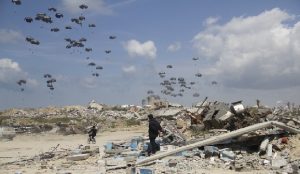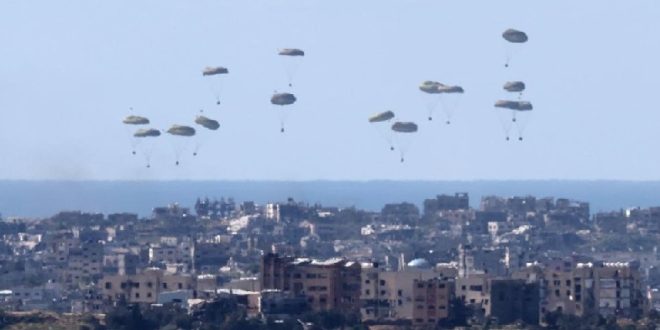31-03-2024
GAZA CITY: One thousand miles east of Gaza, large blocks of aid are being loaded on to a US military transport plane, its crew silhouetted by the morning sun glancing over the desert landscape around Qatar’s al-Udeid airbase.
They push 80 crates into the plane’s cavernous interior, each canvas-wrapped block strapped to a cardboard pallet and topped with a parachute.
 Feeding Gaza is now a complex, risky, multi-national operation. The RAF carried out its first two aid flights this week. France, Germany, Jordan, Egypt and the UAE have also been taking part.
Feeding Gaza is now a complex, risky, multi-national operation. The RAF carried out its first two aid flights this week. France, Germany, Jordan, Egypt and the UAE have also been taking part.
This was the 18th mission flown by US forces. Dropping 40,000 ready-prepared meals into the tiny, besieged war-zone requires them to make a six-hour round trip from Doha.
It is more expensive and less efficient than other ways of delivering aid and it is also harder to control.
Earlier this week, 12 people are thought to have drowned while trying to retrieve aid parcels that fell into the sea. Another six were reportedly crushed in the stampede to reach it.
“We’re very aware of all the news, and we’re trying to limit casualties,” said Maj Boone, the mission commander, standing beneath a large American flag at the entrance to the cockpit.
“(We’re doing) literally everything we can. We use a chute that falls at a slower rate to give Gazans more time to see the parachute and get out of the way.
“We also have assets overhead that clear the drop zone, so we won’t drop if there’s any group of people there.”
He said they mapped the route carefully, aiming to land the aid in safer, open spaces along the Gaza coast, but drop the parcels over the sea so that crates with malfunctioning parachutes would drop into the water, rather than on buildings or people. None of that is easy.
 A heavy military cargo plane can be heard for miles around, meaning crowds quickly gather to follow it.
A heavy military cargo plane can be heard for miles around, meaning crowds quickly gather to follow it.
Desperation leads many to take enormous risks to retrieve the aid and many come away with nothing.
Hamas has reportedly demanded a halt to air drops as casualties have grown, calling them “useless” and a “real danger to the lives of hungry civilians”.
The risks are increased by the lack of any organized distribution of the aid once it hits the ground.
As we swing down low over Gaza, the plane ramp opens to reveal the outskirts of the Strip’s devastated capital city, its remaining tower blocks jutting up like lone naked teeth.
American food parcels are being targeted at places where American-made weapons have already made their mark.
The roads beneath us along the coast were busy with people and vehicles, moving quickly in the same direction, apparently racing the plane.
We watched as the parachutes slipped quickly out, shrinking to specks in seconds. Many hung over the water – but two, their parachutes stalled, crashed straight into the sea.
“It’s not perfect,” said US Air Force spokesman Maj Ryan DeCamp when asked whether aid drops were the best approach to Gaza’s hunger crisis.
“We know there’s upwards of two million people who need food on the ground – innocent civilians who did not ask for this conflict – and we’re dropping meals in the tens of thousands. (Int’l News Desk)
 Pressmediaofindia
Pressmediaofindia




